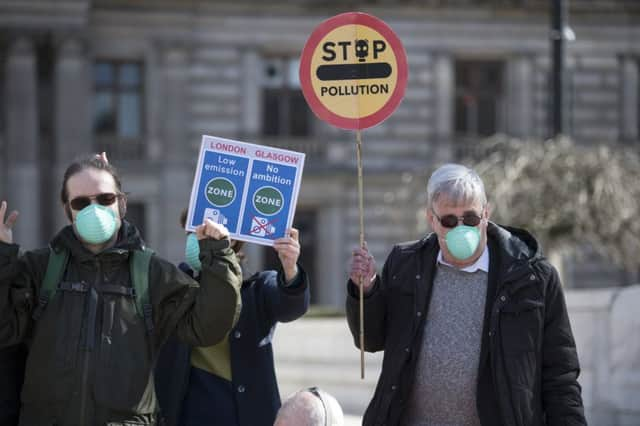Edinburgh should ban lorries and vans in Low Emission Zones '˜from the start' say campaigners


They say it can avoid making the same kind of mis-steps that saw Glasgow being widely criticised for a so-called lack of ambition.
Dr Richard Dixon, director of Friends of the Earth Scotland, insists Edinburgh has a unique opportunity to put in place a system that can ensure clean air.
Advertisement
Hide AdAdvertisement
Hide AdHe said: “The introduction of Scotland’s first LEZ in Glasgow has been a sorry tale, with strong political ambition thwarted by bureaucracy and delay. The Glasgow LEZ has to be operating at the end of this year, and we may still get an increase in the target for clean buses and see a date set for other vehicles which isn’t at least three years hence, but currently it looks pretty unimpressive.
“The biggest problem was that Glasgow Councillors were talking to the bus companies with one hand tied behind their backs because the Scottish Government took so long to spell out how much of the new LEZ funding was available to them and for what. It turns out there is enough money to get 75% of the buses in the city up to the latest standards by the spring of next year but, sadly, the council may be stuck with much lower targets for the early years.”
“Edinburgh has two major advantages. Firstly, the city has until 2020 to introduce its LEZ, giving an extra two years to get things right, which means more than just buses can be included from day one. Secondly, the bus fleet in Edinburgh is already much more modern than the tired buses on the streets of Glasgow, meaning making sure every bus meets the latest standards will be quick and relatively cheap. An added bonus is that Edinburgh’s main bus company is actually interested in reducing emissions, unlike the two main players in Glasgow.
“Extra time and a simpler job with the buses means there is no reason why lorries and vans can’t also be included from the start, with taxis and private cars to follow soon after. The great prize of clean air throughout the capital is only a few years away.”
Advertisement
Hide AdAdvertisement
Hide AdCllr Chas Booth, Edinburgh Greens transport spokesperson, said:“Two hundred people meet an early death due to air pollution in Edinburgh each year, according to public health experts. This is a shocking state of affairs, and makes action from the council to clean up our air all the more urgent. Edinburgh should be ambitious in bringing forward plans to allow everyone to breath easily again, and that means swift action, bold scope and effective delivery.
“The Glasgow LEZ scheme is expected to be introduced at the end of 2018. Edinburgh should not be far behind. We must ensure that all the worst-polluting vehicles are covered by the scheme, including buses, lorries and vans, from the outset. Taxis and cars should also be included at an early stage. To be effective, the capital’s low emission zone can’t be introduced in isolation – it must be part of a wider push to encourage cycling and walking, and discourage people from using private cars.Crucially, Edinburgh needs the support of the Scottish Government, both in terms of cash for effective implementation, and new powers over issues such as workplace parking, so we can take concerted and effective action to improve air quality in the city for residents and visitors alike.”
Transport and Environment Convener, Cllr Lesley Macinnnes, said: “We are currently in the process of developing plans for a LEZ in Edinburgh, which will take into account a wide range of factors, including feedback from other cities that have introduced similar schemes. While the LEZ will be an effective way to tackle poor air quality in the city centre, it is just one of a number of tools. It is important that any proposals evolve in tandem with the many ongoing projects helping to reduce emissions, including investment in a sustainable fleet, improved public transport and Central Edinburgh Transformation, which will create a more welcoming environment for pedestrians and cyclists.”